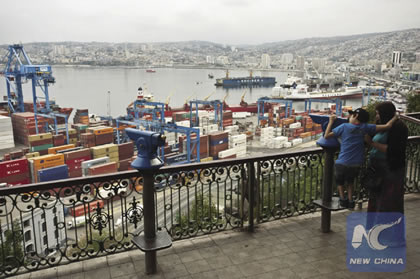HELGA ZEPP-LAROUCHE IN DIALOG WITH
THE PERU ASSOCIATION OF ECONOMISTS
The New Silk Road Concept,
Facing the Collapse of the World Financial System
Helga Zepp-LaRouche Keynote to 23rd National Congress of
the Association of Economists of Peru
November 17, 2016
A [PDF version of this transcript] appears in the November 25, 2016 issue of Executive Intelligence Review and is re-published here with permission.
A question-and-answer session immediately followed Mrs. Zepp-LaRouche’s pre-recorded video presentation to the Nov. 17 XXIII National Congress of the Association of Economists of Peru, held in Pucallpa, Ucayali in Peru's Amazon region. Her answers have been back-translated into English from the simultaneous interpretation into Spanish.
Back to Keynote Address
Transcript of Questions and Answers
Question: What sort of credit system would be created for the financial platform for construction of regional infrastructure, such as the bi-oceanic rail corridor?

Helga Zepp-LaRouche |
Zepp-LaRouche: Well, I think that this is a matter of negotiations among the participating countries, that is, Brazil, Peru, probably Bolivia, China. I think that China has already invested a lot in similar projects around the world. For example, China has invested $46 billion in Pakistan to develop a corridor connecting China to the Gulf coast. This is a project which has great potential for the future, because finally it is going to link up with India, and this is going to be one of the factors of stability in the relationship between two countries that, often in the past, have had tensions.
So, I think that China will probably participate in investing in this bi-oceanic corridor, and there obviously has to be a multilateral credit arrangement that takes into account the duration and the amount of time that it will take to build the railroad, and when it will begin to operate, and how it will be linked to other projects.
So that generally is not a big problem, so long as these credits are channeled solely to the development of infrastructure. And in that case, the investment should be measured not simply as the cost of the rail link, but you also have to calculate the medium and long-term increase in all of the other areas of industry, agriculture, and trade, which will come about as a result of the investment in infrastructure.
Throughout history, investment in infrastructure has been the precondition and the starting point for the industrial transformation of any country. So people who say that infrastructure is too expensive, and that therefore it should be privatized—that’s a mistake. Because the idea isn’t to have privatized infrastructure, but rather to view infrastructure as the necessary precondition for the increase and industrial progress of the continent, and of the whole region.
Question: How can changes in economic mentality in China transform the world? How can they help address problems that have arisen under the existing economic model?
Zepp-LaRouche: I think that China, clearly, still has a system based on a single party, and naturally it is the Communist Party—however, with Chinese characteristics. And I can tell you that it is my deepest personal conviction that, far more important than the communist aspect as such, which goes back to Karl Marx—who, by the way, was born in the same city that I come from in Germany, Trier—in any case, the Chinese Communist Party is greatly influenced by the philosophy of Confucius. Confucianism has been the state philosophy of China for thousands of years. And it has a system of values which is totally different from the system of the neoliberal monetarist theory.

Xinhua/Jorge Villegas
China’s One Belt, One Road Initiative has been key in diversifying bilateral trade. Shown, container shipping in the port of Valparaiso, Chile. |
Confucianism places great emphasis on knowledge, on learning throughout life, by everybody in the whole world, especially the labor force. It also places great emphasis on excellence, that one always has to try to achieve results in the best manner possible. It places great emphasis on innovation: never do the same thing twice, always progress in technological leaps, leapfrogging ahead. And China has shown that it is not necessary to repeat all of the stages of industrialization which the industrialized countries have gone through in a chronological fashion, in the way they did. Rather, you can choose and define areas in which a country can be a true world leader, and place great emphasis on the education of students in that specific area.
And that way, in a growing division of labor in a world which is increasingly specialized and differentiated on the level of the world economy, every country absolutely can profit from that system. And although there may be a multi-party system or there may be things from the old paradigm, or values from the old system that go along with globalization that only emphasizes obtaining the immediate maximum financial profit in the short term, I think that what is most profitable in the long term, and even in the medium term, is the Chinese model, which is based on the best aspects of what caused the industrial revolution in any country. Whether it be Germany, Russia, or the United States, there has always been a model which is based on physical economy. And I think that that, perhaps with greater difficulty, can be repeated in other countries.
But it absolutely can be achieved, if you have a national mission, and if that national mission is something coherent with the requirements of all mankind. And I think that this goes to the entire question of “The New Silk Road Becomes the World Land-Bridge,”—that is, that we are not talking only about transportation lines from A to B, but rather of the total industrialization, a transformation of all continents and all parts of the planet, which so far have not fully developed.
In a certain sense, I think that once we proceed from that perspective of the totality, that humanity has to achieve a higher level of development in which every human being on the planet must participate—I think that, in that way, even a country which does not have the characteristics of China, can learn from the Chinese model about how to achieve that.
Our Historic Opportunity Right Now
Question: Helga, you are known as the “Silk Road Lady.” On what principles have you based yourself, to develop that concept of a world model?
Zepp-LaRouche: Well, I think that it actually began, in a certain way, when I went as a young journalist to China in 1971; I had the opportunity to go there on a cargo ship of a company that had traded with China for over 100 years, and therefore wasn’t affected by the Cultural Revolution. And I was very curious to visit and know China in the period of the Cultural Revolution—which was a very difficult moment, but I was very happy to have been able to be there.
And that experience had a big impact on me, because people were very unhappy. There were the Red Guards, who went into people’s houses at night, and took them out of their houses and threw them in jail. The population was terrorized. But at the same time I encountered ancient Chinese culture, which impressed me very much, from that time on.
View full size
Schiller Institute Helga LaRouche in Beijing in 1996, calls for a Eurasian Development Bank and “an emergency meeting of the principal nation-state powers for the purpose of establishing a new international monetary system.” |
I developed a great interest in Chinese history and culture. And based on the general experiences of that trip, which also took me to Senegal, South Africa, Malaysia, Thailand, and Singapore—when I returned from that trip, I had the profound conviction that the underdevelopment of the developing countries was something so horrible. I could give you a lot of details of what I saw: how children slept in horrible conditions; and how a woman wanted to sell me some small thing, and I had to tell her that I didn’t have any money to help her. But I returned with a profound conviction that the underdevelopment of the developing sector was something that had to be rectified.
And, fortunately, I came across the economic theories of Lyndon LaRouche, who was promoting exactly that. He was promoting true industrialization. The Third World has to be developed. And that was at the beginning of the 1970s, when the oligarchy was imposing the paradigm that began with the idea that there shouldn’t be any development. They began to talk about over-population; about sustainable development, which from the very beginning really meant that there should not be any development at all. And the Club of Rome, about which I spoke earlier, and their idea that there are limits to growth, and now that there is an equilibrium and all growth must be stopped.
Lyndon LaRouche’s movement opposed all of that and did in-depth studies and published development programs, such as for Africa. If you look at the map of Africa and of Latin America in the 1970s, they had a lot in common. They did not have infrastructure, or perhaps they just had one railroad which went from a mine, carrying raw materials to a port, for the colonialist exploitation of the resources. But the domestic development of infrastructure and its development was something that simply didn’t exist. And that’s why the idea of a transcontinental railroad between Brazil and Peru is something that is so, so crucial, because it is exactly the kind of infrastructure that every country should have, in every continent, as a precondition for industry and agriculture.
So we first did a plan for the development of Africa, and then at the end of the 1970s and beginning of the 1980s, with President Jose Lopez Portillo of Mexico, we proposed the idea of Operation Juarez.
We also worked with Indira Gandhi at the beginning of the 1980s, with a 40-year development plan for the development of India, which she began to implement. After they killed her, we worked with her son, Rajiv Gandhi.
My husband, Lyndon LaRouche, proposed a plan for the economic development of the Middle East, called the Oasis Plan. And when the Berlin Wall came down in 1989, it was clear that we had to connect Europe to Asia through infrastructure corridors, to create the same advantages of development and industry for the landlocked regions as the seacoasts, by connecting them to coastal areas and rivers.
Therefore the idea of “The New Silk Road” is an idea which we naturally supported when President Xi Jinping adopted it in 2013. We published all of those projects in a single report which is called The New Silk Road Becomes the World Land-Bridge.
So, in a certain way, we can say that over the last 40-45 years, we have participated directly in those projects, all on the basis of the most profound conviction that 500 years of colonialism and imperialism, and these policies, have led to many countries of the Southern Hemisphere having to accept conditions so horrible that people who live there simply cannot achieve their creative potential, which all human beings have. In the past, only a privileged elite could develop that potential, while many, many people don’t even have the money or the possibilities of educating their children properly.
And I think we have reached the time in which that condition, which is an unjust condition of Mankind, can be overcome—not just in our lifetimes, but even in the next few years. Because if we look at the speed with which China has been able to progress with this idea of One Belt, One Road, and with the New Silk Road, it is truly impressive. In China, they have changed in an unprecedented manner.
So I have a lot of optimism that in the next years, we will have forgotten hunger; extreme poverty will have ended; that every child will have the opportunity to go to a good school; and we will truly be able to make a leap and achieve a Mankind worthy of that name.
Thank you very much.

